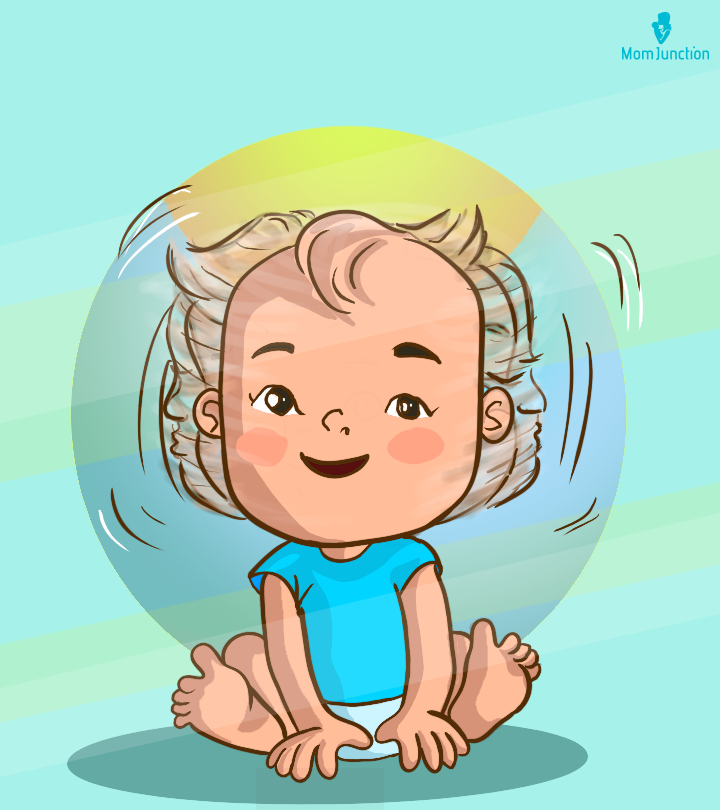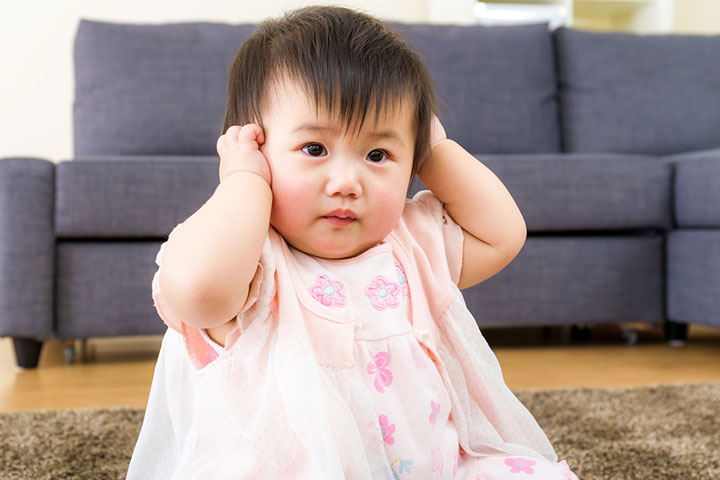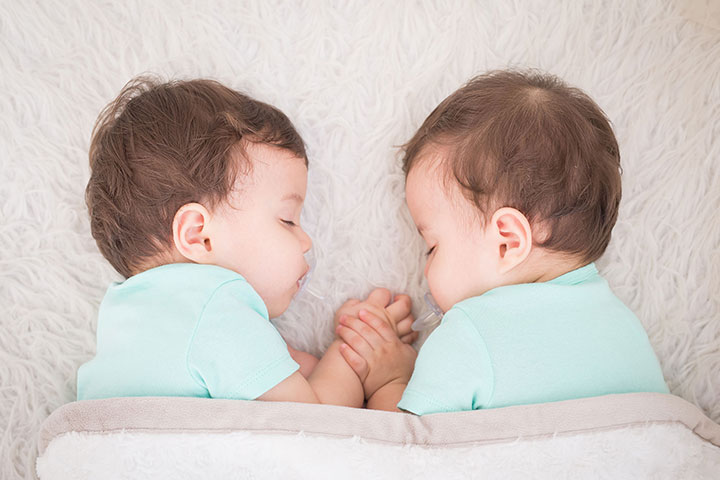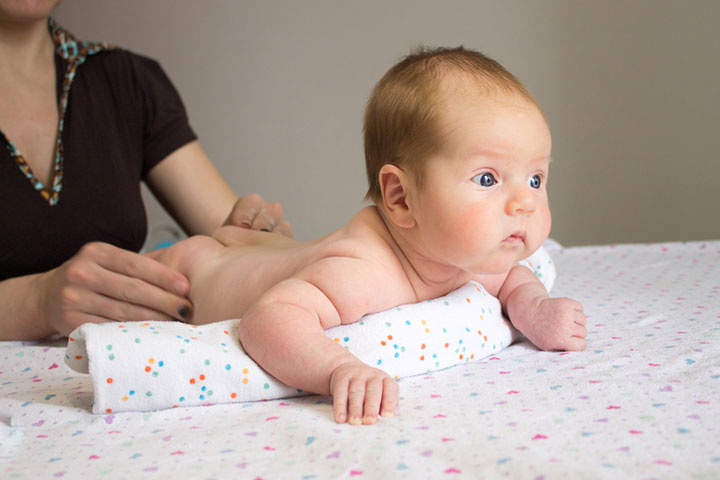You may notice a baby shaking their head while interacting with others or playing. Shaking their head from side to side is a common way older infants react to questions or communicate. Though head shaking is common in little ones, it could also indicate neurological or developmental problems.
Read this post to learn more about the typical and uncommon reasons babies shake their heads, how to deal with it, and when to consult a doctor.
Normal Causes Of Baby Head-Shaking
Are you wondering why babies shake their head from side to side? If you notice your baby is happy and healthy, then head-shaking is nothing to worry about. Here are a few usual reasons why your baby may shake their head.
1. Developing motor skills
Once your baby’s neck muscles are developed, they test their ability to hold up and move the head. It is a part of normal developmental milestones. Usually, by the end of the first month, a baby starts moving their head from side to side. The Centers for Disease Control and Prevention mention that by the age of two months, they can raise their heads while on their tummy (1). It may be jerkier initially due to developing muscle control and coordination.
2. Self-soothing
A baby shakes head side to side as a part of self-soothing. It can be a natural tactic to calm themselves down to sleep. You may notice this behavior right before your little one falls asleep.
Leah Alexander, MD, FAAP, a board-certified pediatrician in New Jersey, says, “If your baby starts shaking their head from side to side, it may be a sign that they are anxious, overstimulated, or trying to fall asleep. Self-soothing is a completely harmless way for babies to try and make themselves feel better in new situations.”
3. While breastfeeding
While breastfeeding, babies may shake their head to latch. It can be one of the first head movements babies may make. During nursing, they might also shake their head as a gesture to express excitement. Though your baby may support and move their head side to side, you should support their head while feeding until the age of three months.
4. Playing and interaction
Babies start to move their heads as a part of social interaction in the initial months. You may notice increased head shaking when your baby is excited.
5. Communication
A baby may use head-shake as a mode of non-verbal communication. As the baby grows older, they may shake their head as a reflex, along with making sounds to express emotions or demand something.
Dr. Alexander says, “Most babies start shaking their heads to express a ‘no’ between 13 and 15 months old. However, some may start earlier and some may not start until later.”
Baby Head-Shaking Causes That Are Not Normal
If head-shake is associated with other physical and behavioral symptoms, then it could be due to developmental problems or certain medical conditions. We will touch on a few:
6. Ear infection or fluid collection in the middle ear
According to the National Institute on Deafness and Other Communication Disorders, five in every six children will experience at least one ear infection by the time they reach their third birthday. Ear infections lead to pain or discomfort. This will often be associated with fever, crying, and other signs of illness. Ear tugging along with head-shaking may then occur (2).
7. Autism spectrum disorder
Babies with autismiXA developmental disability leading to issues with social communication and interaction or repetitive behavior tend to shake their head involuntarily. Frequent headbanging is sometimes observed with this disorder. In such cases, check for these associated behavioral traits.
- Does not respond to sounds
- No reaction if you call their name
- No smile or eye contact
The Centers for Disease Control and Prevention emphasizes that early diagnosis of autism disorders may improve the child’s quality of life due to early interventions and less parental stress (3).
8. Myoclonic epilepsy
Myoclonic head jerks or spasms can be seen in babies during epilepsyiXA neurological condition that makes one more susceptible to recurrent seizures. According to the healthcare experts at the Boston Children’s hospital, these seizuresiXA medical condition that causes an involuntary and uncontrollable surge of electrical activity in the brain tend to occur in clusters and may continue to happen multiple times in a day for several days. This may be due to serious neurodevelopmental disorders (4).
9. Spasmus nutans
It is a disorder where babies do head-bobbingiXAn act of moving the head up in short and quick movement with rapid eye movement called nystagmus. Sometimes, they may hold their neck in an abnormal position. As per the information available in the US National Library of Medicine, this condition usually occurs between four months and one year of age and resolves later in life (5).
10. Shuddering attacks
Shuddering attacks in infants are involuntary head and upper extremity motions that occur during routine activities but do not impact consciousness. These brief episodes resemble shivering, can be frequent, and may cause alarm among parents due to their seizure-like presentation. They are also sometimes misdiagnosed as epilepsy. Shuddering attacks are characterized by stiffening, tonic posture, and fast shivering motions of the head, upper extremities, and occasionally the trunk. These events typically last from a few seconds to 15 seconds. They usually resolve or improve by age two or three (6) (7).
Repetitive Side-To-Side Head-Shaking When Sleeping
Shaking of head side-to-side during sleep can be a symptom of rhythmic movement disorder (RMD). It is a neurological disorder with repeated movement of large muscles before or during sleep, especially in infants. It usually involves head and neck movements and has the following associated symptoms (8).
- Headbanging
- Body-rocking
- Head-rolling
This condition might be genetic since it is often seen in families and among twins. Seek a doctor’s opinion if you suspect RMD.
When To Consult A Doctor?
You may consult a pediatrician if you notice any of the following events, along with head shaking.
- Poor interaction with caregivers
- Abnormal eye movements
- Headbanging causing hair loss and injury
- Increased head-shaking during anxiety
- Trying to self-hurt
- Delay in development
- No response to sounds
- Head-shaking after two years of age
How To Stop Babies From Shaking Head?
Head shaking may cause dizziness and disorientation in babies, and it may result in falls. It might also increase the risk of hitting the crib, table, or wall. You may follow the following tactics to prevent your baby from head-shaking.
- If your baby does it before sleep, then try to find an alternative method to soothe them before they go to bed.
- If it is due to stress or agitation, then create a calm environment in their room.
- Giving a massage could help a baby to relax.
- If you sense that the baby shakes their head as a way to throw tantrums, then do not give in to their demands. As soon as attention is given (even negative attention) it enhances the behavior.
Baby shaking head when awake and happy is typical and a good sign of motor skill development. They may use this action to interact and communicate. However, if you notice them shaking during their sleep or together with other concerning symptoms, do not overlook it. Although typical, a baby shaking head with crying, rapid movement, and other signs can indicate underlying morbidity that may require medical intervention. So stay mindful of your baby’s movements and behavior, and do not hesitate to consult your child’s doctor for prompt diagnosis and treatment.
Key Pointers
- If a baby is healthy and happy, parents shouldn’t worry about head-shaking in babies.
- Babies shake heads to hone their ability to keep holding their head up, self-soothing, or position their head to latch on to the nipple while breastfeeding.
- Shaking head side-to-side is the most common way older infants respond to a question or communicate.
- However, excessive or repetitive head-shaking indicates an underlying problem that a pediatrician must evaluate.
Learn about the 8 common early signs of autism. Discover what signs to look for in your child’s development and how to get help.













